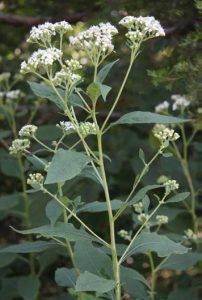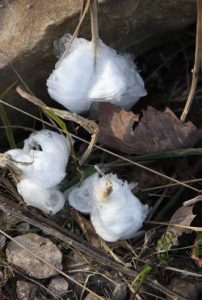Valley Water Mill Plant Catalog
The Origins of the Valley Water Mill Plant Cataloging Project
by Linda S. Ellis
Springfield Plateau Master Naturalist
In the fall of 2011, I took the training classes provided by the Missouri Department of Conservation and became a member of the Master Naturalist volunteer force. Every trainee is asked to undertake a Capstone project to aid conservation causes in our area and I chose to create a plant catalog for the 70-acre park.
The cataloging team began in the fall of 2011 and walked the trails once a month between the end of March and first frost. I had created a basic plant list for a “Together Green” event at Valley Water Mill a number of years ago so we started with that and began to add to it. By October, 2016, the team has visited the park on 17 occassions and to date have cataloged 399 species of herbaceous forbs, shrubs, woody vines and trees.
Many people have been involved in this effort in the Plateau chapter. The Watershed Committee would like to thank the following Master Naturalists for participating:
Kathryn Boone, Linda Bower, Mark Bower, Christine Chiu, Stephanie Davidson, Linda Ellis, Carl Haworth, Jesse Haworth, Sue Helm, Sharon Hughes, Shelly Jones, David Ketchum, Barb Kipfer, Bob Kipfer, Debbie Lewis, Mary McCarthy, Marilyn Owen, Bob Ranney, Alane Roy, Marlyss Simmons, & Patricia Tursi
Our efforts were encouraged by Rob Hunt, former Watershed Center Coordinator and Mike Kromrey, Director of the Watershed committee.
A special thanks to Dr. Michelle Bowe, professor of botany at Missouri State University for her contributions to plant identification and to her student, Dr. Jeremy Keene. Thanks, also, to Dr. Ioana Popescu, plant biologist at Drury college, for bio-blitz contributions.
To identify and learn more about non-native species and control methods, visit the Missouri Department of Conservation website:
Native Plant Recommendations for Missouri Gardeners
Here is a list of 12 native plant species that are recommended for home gardeners in southwest Missouri. The list is arranged by blooming dates so something will be coming into flower each month if you plant them all. Native plants have evolved here and are accustomed to our seasons. They are usually drought tolerant, don’t need pampering, and are nectar sources for butterflies and hummingbirds.
By Linda S. Ellis
Springfield Plateau Master Naturalist
Rose Verbena
(Glandularia canadensis)
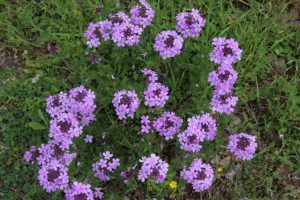
Blooming Date: March-April
Rose verbena is low growing and ideal for borders, rock gardens or any spot with lots of sunlight and well-drained soil. Early emergent butterflies depend on this plant for a nectar source.
Coneflowers
(Echincacea pallida)
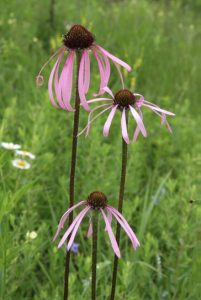
Blooming date: May-June
Pale purple coneflower is a standard for any native garden. It is low maintenance, a great summer nectar source and seed source for birds in the fall. If your garden is shady, you may want to use purple pale coneflower (Echinacea purpea) instead.
Spiderworts
(Tradescantia ohioensis)
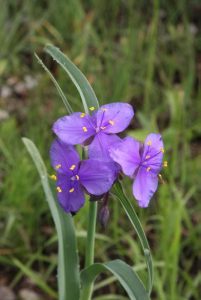
Blooming Dates: May-June
Ohio spiderwort is a shade tolerant native that will thrive in early summer. There are many species of spiderworts and some bloom earlier and do well in full sun.
Bee Balm
(Monarda fistulosa)
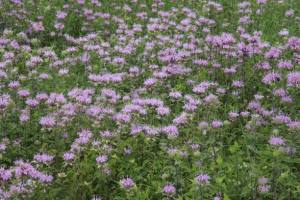
Blooming Date: June
Bee Balm, as the name implies, is a great bee and butterfly attractor. This plant is in the mint family and will spread by seed which makes it a good choice for meadow plantings. In the home garden, it won’t take over like other mints can.
Milkweeds
(Asclepias tuberosa)
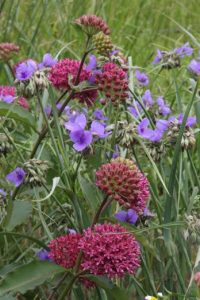
Blooming Dates: June-July
Milkweed is the plant that monarch butterflies depend on for a larval food source. The orange variety, called “butterfly” milweed or the purple variety (Asclepias purpurescens) are probably the showiest for the garden and a necessity for attracting these endangered pollinators.
Royal Catchfly
(Silene regia)
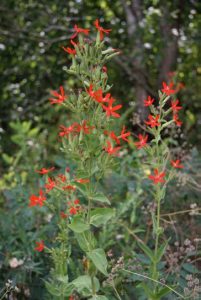
Blooming Date: July
Royal catchfly is called this because of the sticky hairs on this carnation-family plant. The blue-green foliage is very attractive in a garden and a must if you enjoy hummingbirds. Give this one full sunlight.
Passion Flower
(Passiflora incarnata)
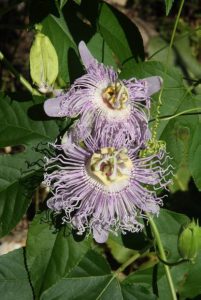 Blooming Dates: July-September
Blooming Dates: July-September
Passion Flower is a hearty vine that produces edible fruit and is the larval plant for Gulf and Variegated fritillary butterflies. It is drought tolerant, thrives in full sun, and will do well if trellised.
Blazing Stars
(Liatris sp.)
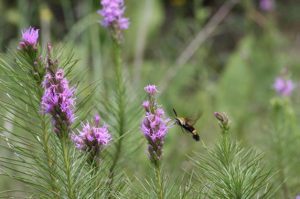 Blooming Dates: July-September
Blooming Dates: July-September
Commonly known as prairie blazing star or gayfeather, this plant will attract many species of butterflies. The two best species for the home gardens are Liatris punctata var. mucronata (shown) and Liatris pycnostachya.
Partridge Pea
(Chamaecrista fasciculata)
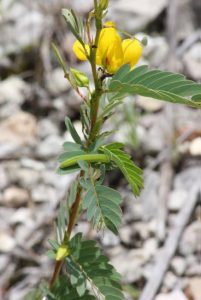 Blooming Dates: September-October
Blooming Dates: September-October
Partridge Pea is in the bean family so planting it will help fix nitrogen in the soil. The caterpillars of several of the sulfur butterflies use this plant and their chrysalis mimics the spent flowers.
White Crownbeard
(Verbesina virginica)
Blooming Dates: September-October
This plant is a great nectar source for migrating butterflies and produces “frost flowers” from sap extruding from the white crown beardfrost flowers stems in freezing weather.
Asters
(Symphyotricum novae-anglia)
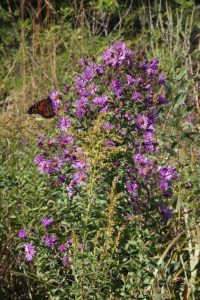 Blooming Dates: September-October
Blooming Dates: September-October
There are more than 30 species of asters in the Ozarks and can be either purple or white. Asters are one of the last plaster purple ants to supply nectar to migrating butterflies and is occasionally used by painted lady butterflies as a larval food plant. The New England aster likes wetter soil so it is good in water feature plantings, such as rain gardens. This aster can reach several feet in height so it is good to provide support when it is in full bloom.
Oblong-Leafed Aster (Symphyotricum oblongifolium)
Blooming Dates: October to frost
Oblong-leafed aster is a short, bushy plant that is very drought tolerant and thrives in rocky soil. The short nature of the plant makes it a good choice for naturalizing as it will self seed without becoming invasive.

